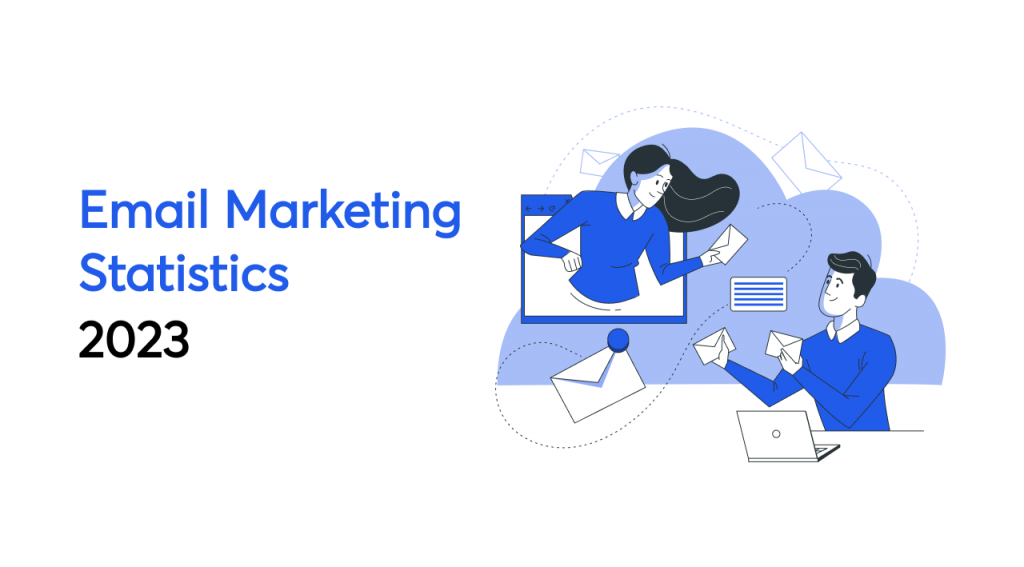
Email marketing is a great way to get data-backed marketing with a high return on investment. It should be a logical next step if you have a contact list of loyal customers or interested subscribers. Since success depends on a careful approach to triggering interactions, benchmarking and strategy are the cornerstones of successful email marketing campaigns.
Even though we live in the day and age of social media, business owners should be mindful that it won’t offer the same levels of engagement or return on investment data as email marketing. Email usage is much more consistent across age groups, and it’s the first thing 58 percent of people check when they wake up in the morning.
Continue reading to learn more about email marketing’s importance through the highlighted statistics below.

Key Takeaways
- More than 90 percent of survey respondents say email marketing is important to their company’s overall success.
- Email is considered one of the most effective channels for marketing, with 79 percent of marketers placing it in their top 3.
- The global market for email marketing software was worth 7.5 billion dollars in 2020. By 2027, it is estimated to reach 17.9 billion dollars.
- More than half the world’s population (over 4.2 billion people) were active email users globally in 2022. By the end of 2026, that figure is projected to go over 4.7 billion.
- 72 percent of consumers say email is the main resource of business communication.
- Brands made $36 for every U.S. dollar they spent on email marketing.
- The average open rate for 178,161,675 emails sent was 34.97 percent, the average click rate was 22.04 percent, and the average conversion rate was 28.04 percent.
General email marketing statistics
If your inbox appears to be overflowing, there is a reason behind it: email marketing is effective. Businesses are becoming savvier in making sure every email counts. Hence, one way they are doing this is by emailing you more frequently than ever.
Most businesses consider email marketing a key element to their success
More than 90 percent of survey respondents say email marketing is important to their company’s overall success. 41 percent say it’s very vital—up nearly 30 percent since before the pandemic in 2019. Hence, email is considered one of the most effective channels for marketing, with 79 percent of marketers placing it in their top 3.
Email marketing is growing as a priority for businesses
Nearly 37 percent of companies intend to increase their investment in email overall in 2022.
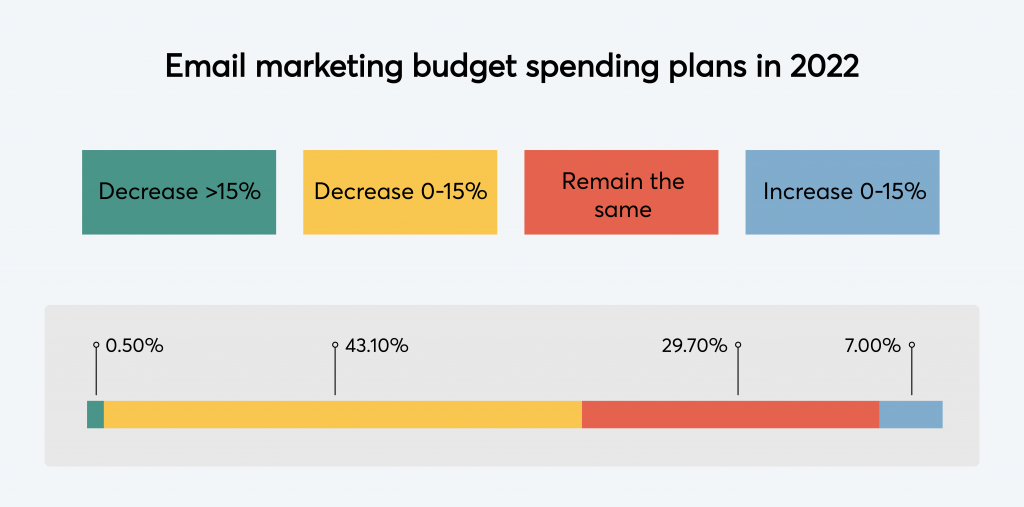
Email marketing revenue is growing
By 2027, the worldwide email marketing market will be worth 17.9 billion dollars, up from its 2020 valuation of 7.5 billion dollars. Even the most skeptical ecommerce companies become enthusiastic email marketing practitioners in the face of this startling statistic.

The number of email users and emails exchanged is continuously increasing
More than half the world’s population (over 4.2 billion people) were active email users globally in 2022. By the end of 2026, that figure is projected to go over 4.7 billion. Knowing this, many businesses utilized email marketing strategies reaching a whopping 319 billion business and consumer emails sent and received daily. This number is anticipated to increase to more than 376 billion emails exchanged daily in the next four years.
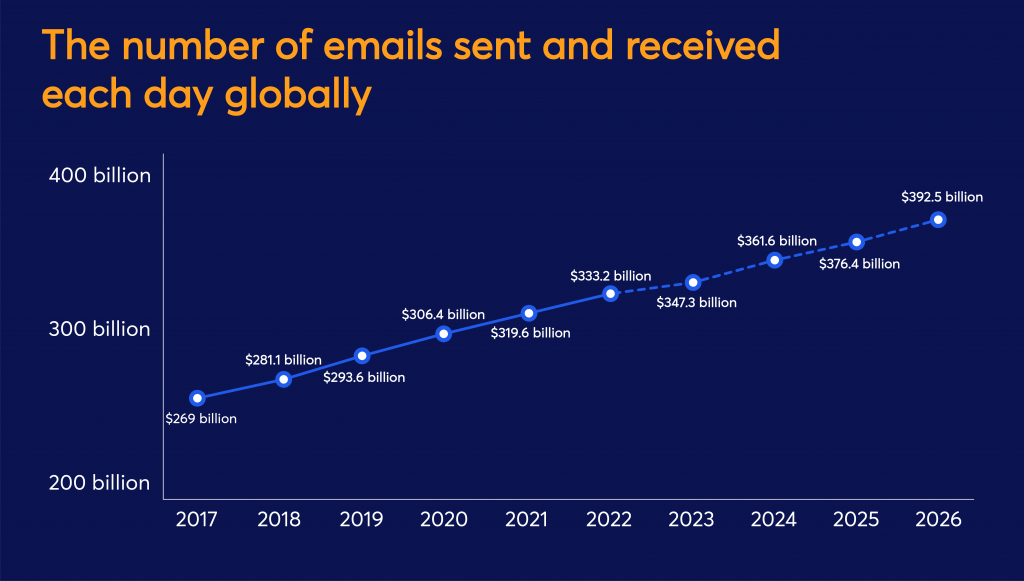
The email marketing software market will see significant growth by 2027
The compound annual growth rate (CAGR) is anticipated to be 13.3 percent over a seven-year period. The global market for email marketing software was worth 7.5 billion dollars in 2020, and it is estimated to reach 17.9 billion dollars by 2027.
Email marketing has proven to offer a great return on investment (ROI)
Brands made $36 for every U.S. dollar they spent on email marketing. Among many industries, the retail, ecommerce, and consumer goods business had the highest return on investment (ROI), at $45.
Email is the preferred channel for business communications
72 percent of consumers say email is the main resource of business communication. When it comes to smartphone users, nearly five out of ten (46 percent) prefer email for business communications.
SMS and WhatsApp were picked by 25 percent, while only 12 percent claimed Facebook Messenger as their first choice. Despite it not being a conventional message channel, TikTok was the choice of nine percent of smartphone users.
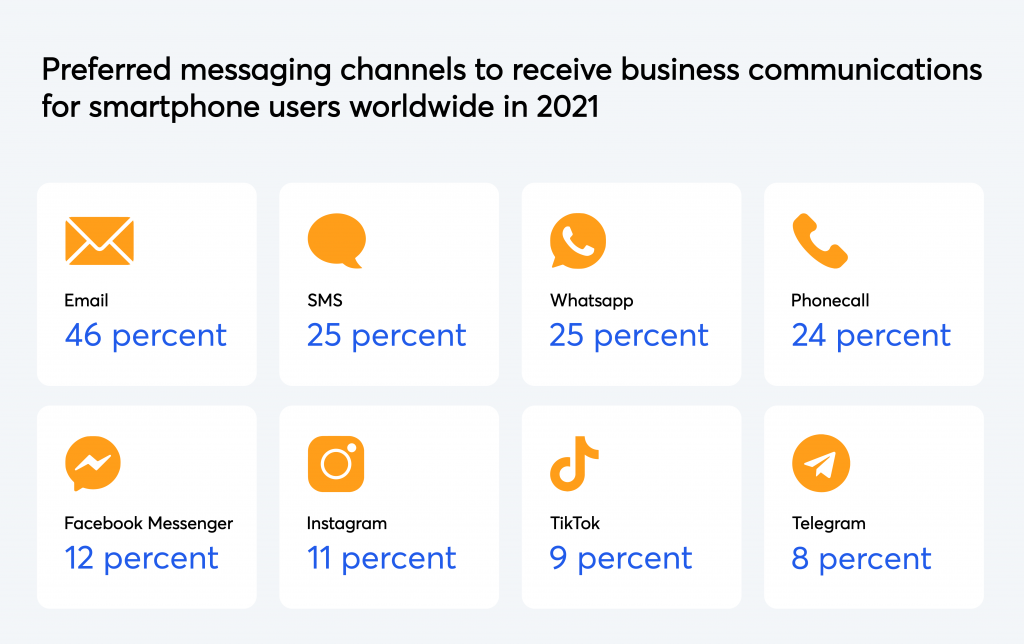
Nonetheless, one out of ten people have changed their preferences in the past years and now favor text messaging over social media and email.
Email marketing as a communication channel for businesses
Email marketing has demonstrated benefits for small business owners, from building the credibility of your brand to increasing sales.
Email is a quick and efficient way to communicate with your audience
34 percent of consumers are more likely to purchase from email marketing, and 21 percent of emails are typically opened within the first hour. Out of the received emails, consumers are more likely to buy from emails that include a coupon or discount (67 percent), check-in with consumers (33 percent), and business updates (28 percent).

Your consumers likely use email; therefore, you should too
No matter what your company is, email marketing gives you the ability to connect with customers 24/7. 60 percent of consumers say they’ve purchased as a result of a marketing email they received.
Knowing your audience better can be achieved by developing a customer avatar
This in-depth investigation of your target market covers their interests, passions, and objectives. This is significant since 71 percent of consumers prefer to purchase products from companies that share their values. Because it’s challenging to forge that kind of emotional bond with a bigger company, 71 percent of respondents said they value the experience offered by small businesses.
There are various emails marketers can send depending on their audience and purpose
While many factors impact email marketing success, the two key players are the welcome email and newsletter.
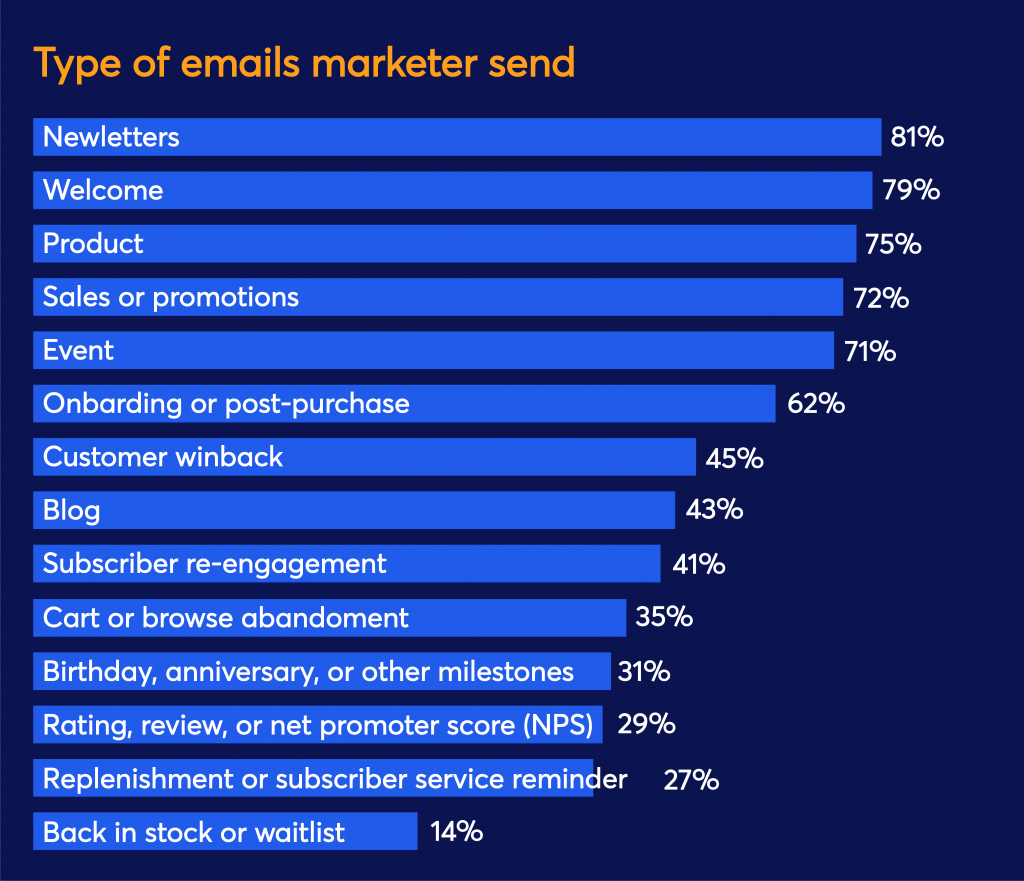
Consistency is key. Customers should be able to immediately recognize your brand
According to studies, brands that maintain a consistent appearance and feel generate 33 percent more revenue than brands that don’t.
Especially with the attention span decreasing, people are reading brand emails for shorter periods of time nowadays. In 2021, they read brand emails for, on average, 10 seconds, according to data from January to August 2021.
On mobile devices, shorter, scannable paragraphs separated by headings, photos, and videos are easier to read than long blocks of text. Particularly 81 percent of people who open their emails on mobile devices will enjoy this.
Personalization – a way to stand out
As the competition keeps growing, businesses should seek a way to grab the buyer’s attention. This is where personalization comes in handy.
In 2021, more than half (55 percent) of businesses were boosting personalization as an email marketing strategy
9 in 10 marketers believed personalization is crucial to overall business strategy since 80 percent of customers are likely to purchase from a brand that provides personalized experiences.
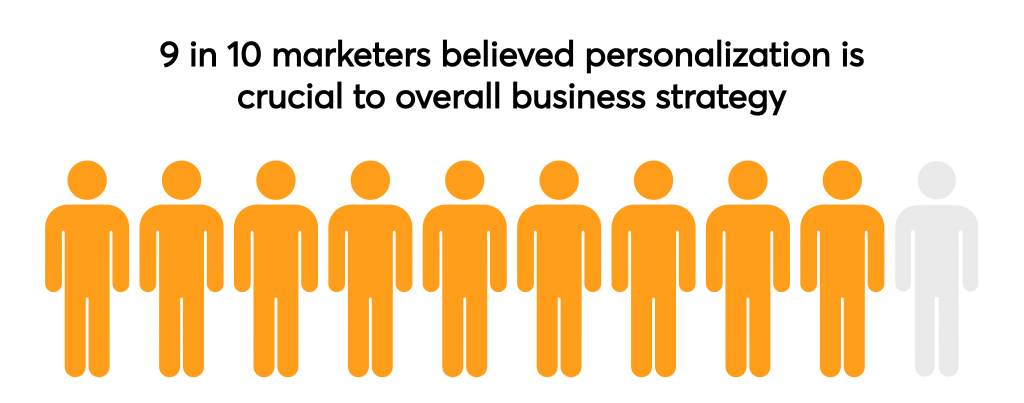
Buyers expected more personalized attention from marketers
76 percent of buyers expected more personalized attention to develop an intimate relationship with your brand. Most (83 percent) customers were willing to share their data to create a more personalized experience.
The best way to personalize your emails is with profile data or by customer segment
4 out of 5 marketers personalized emails with profile data and 64 percent personalized them by customer segment. However, there are also other ways to achieve this goal. Here is the list of approaches you can use.

Segmented email marketing campaigns drive more open and click-through rates.
Segmented email campaigns drive 30 percent more opens and 50 percent more click-throughs than untargeted ones.
Email marketing open rates and click-through rates

As the name suggests, email open rates describe the frequency with which your recipients open your emails. Another great way to check your emails’ performance is to look at the click rates. The click rate is a percentage of how many successfully delivered emails got at least one click. This number shows if your audience finds your emails relevant enough to click through and check for more.
As an email marketing benchmark, the size of your email list should consider both the average open rate and the conversion rate
According to the SaleCycle report, in 2022, the average open rate for 178,161,675 emails sent was 34.97 percent, the average click rate was 22.04 percent, and the average conversion rate was 28.04 percent.
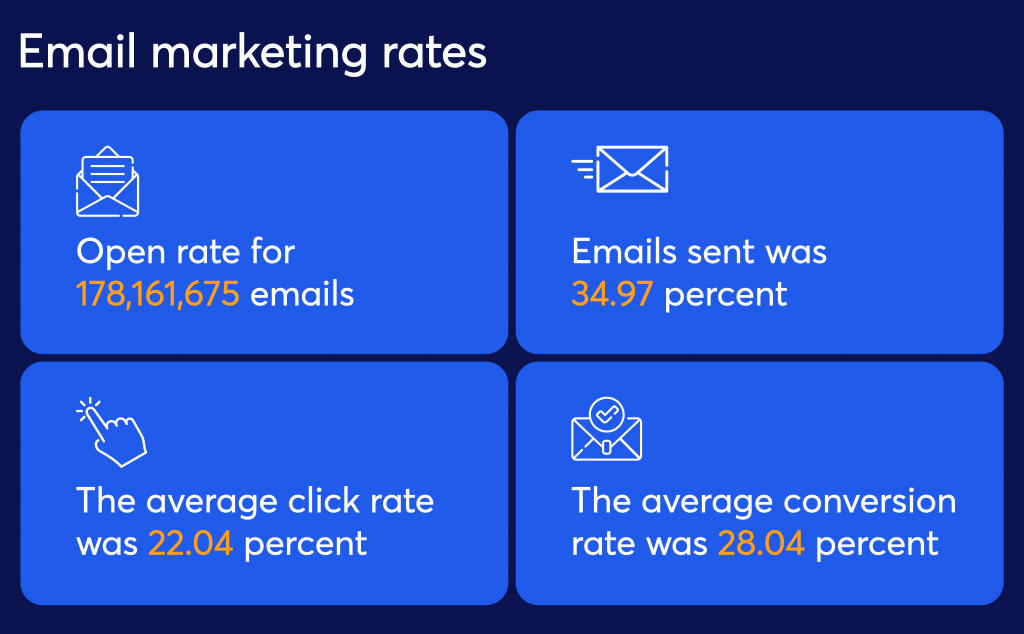
The sector with the best performance overall is retail, whereas the industry with the highest open rates is financial services
Of approximately 1,200 brands, nine of the top 10 come from these industries. The benchmark’s top-performing companies are dedicated to executing targeted campaigns.
Financial services, for instance, have the highest weighted average open rate at 27.1 percent and send emails to just 4.7 percent of subscribers on average, which is the most tailored messaging of any evaluated business.
The average open rate for consumer goods was 17.8 percent after emailing over one-third of their subscribers.
Depending on your audience and their preferences, Tuesday is the best day of the week to send a marketing email
It is important to look further and consider the preferences of your intended audience. This is a crucial step since you might find that your members spend most of their online time on the weekends or at night. Generally, Tuesday has the best open rates and is the ideal day to send marketing emails. This statistic is the result of numerous analyses, but we urge you to look further and consider the preferences of your intended audience.
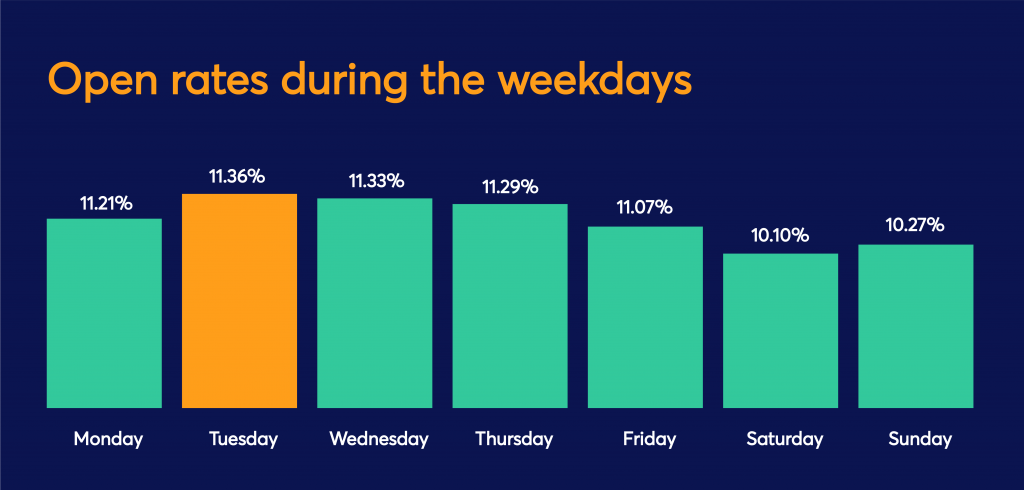
Customers prefer the end of the week to not only open email but also engage with the content
Research shows that Fridays have the best average click-through rates, while Mondays have the lowest.

The subject line has a significant impact on the open email rate
Almost half (47 percent) of email users read emails based only on the subject line, while 69 percent of email recipients flag them as spam. Emails without a subject line collectively have an open rate of 8 percent higher than emails with one, while emails with personalized subject lines have an open rate of 22 percent higher.
Mobile email checking is particularly popular among younger audiences
40 percent of individuals under 18 always open emails on their mobile device first. A staggering 81 percent of individuals prefer to open emails on their smartphones, while only 21 percent do so on tablets regarding their preferred mobile devices.
Email marketing performance by industry
Marketers who want to expand must comprehend the level of engagement required to dominate their sector and combat reliance on third-party data. In addition to open rates, top performers in each business vary in how well they can get visitors to click through to their websites. Compared to just 212,000 in the travel and hospitality industry, brands in the top 20 percent of retail, for example, received almost 1.4 million monthly site visitors through email.
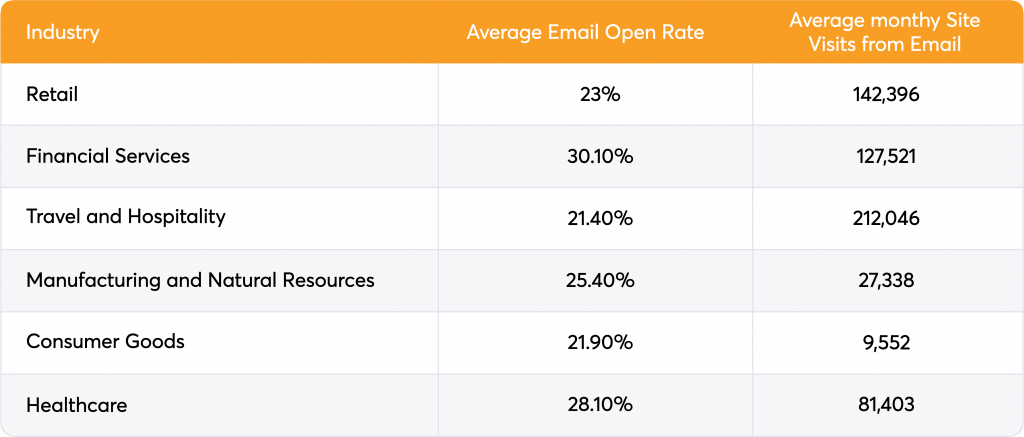
To wrap things up
Email marketing is a value-rich channel of business communication, as evidenced by the above statistics. Whether you’re just starting out or already have a strong strategy, email marketing will give you the tools to take advantage of and grow your online retail store.
In this article, we analyzed the benefits of email marketing and showed you important stats about this marketing strategy. We hope this information persuaded you to spend more time planning email campaigns because it could help you skyrocket sales sooner than you think!